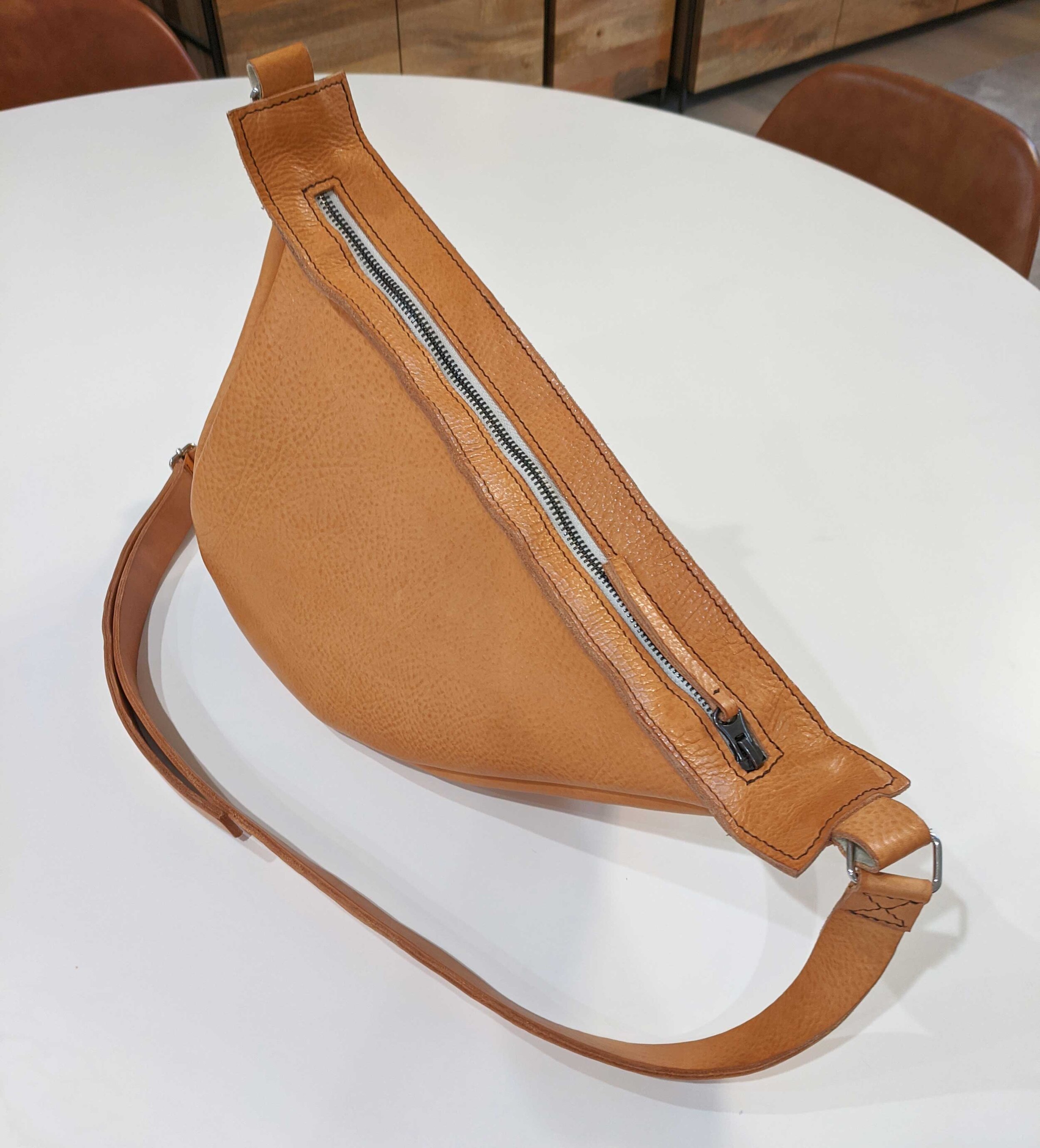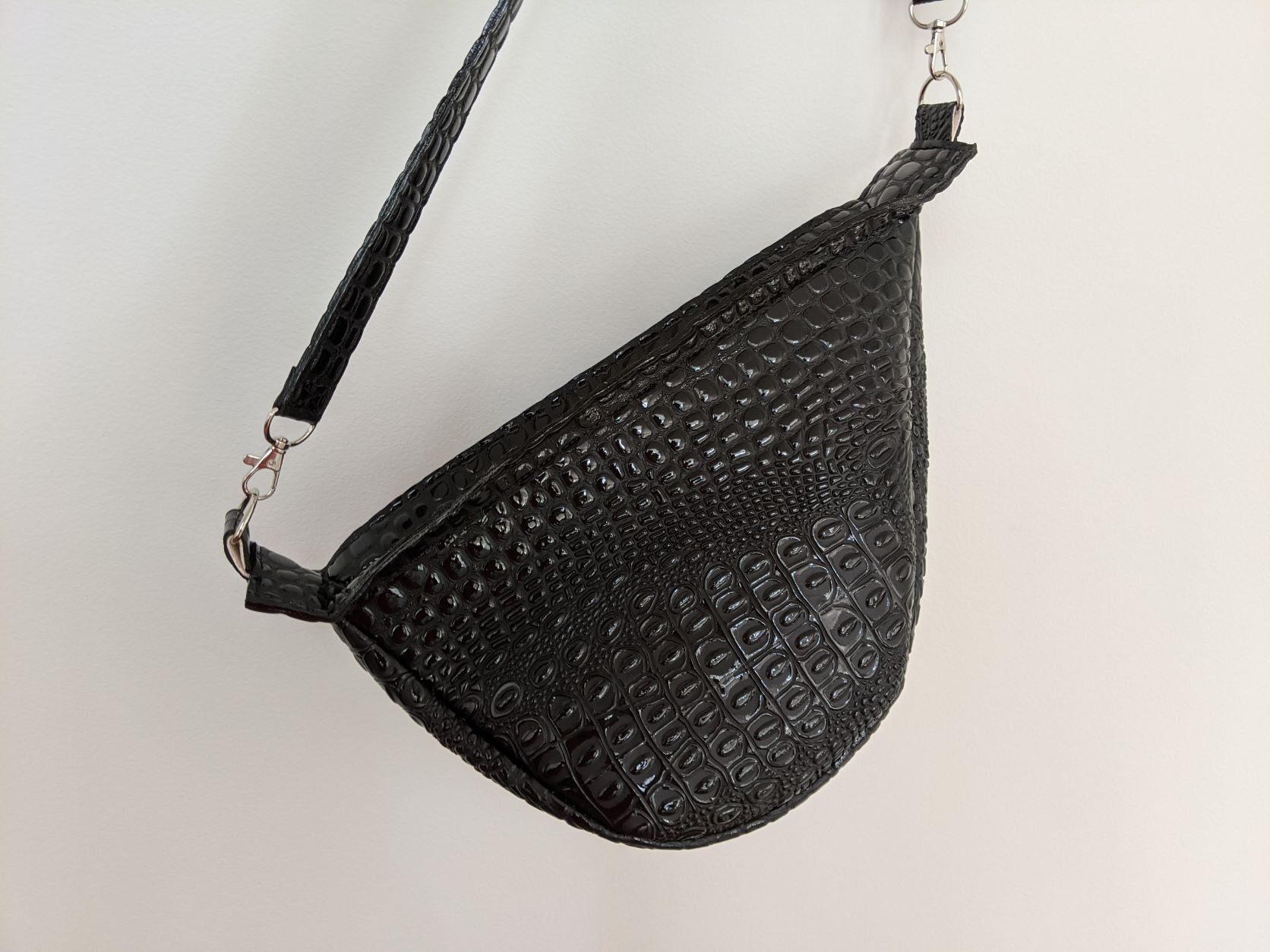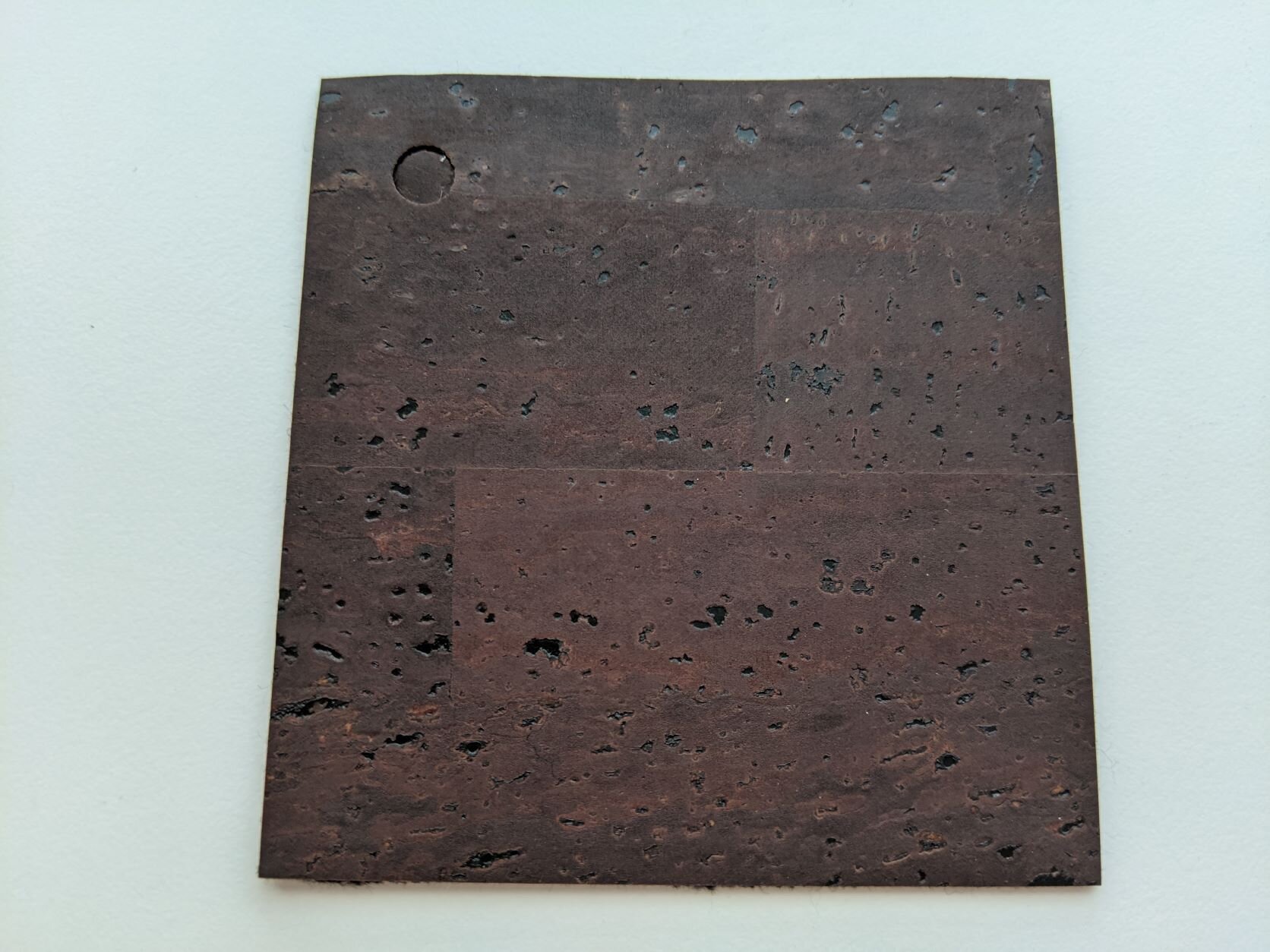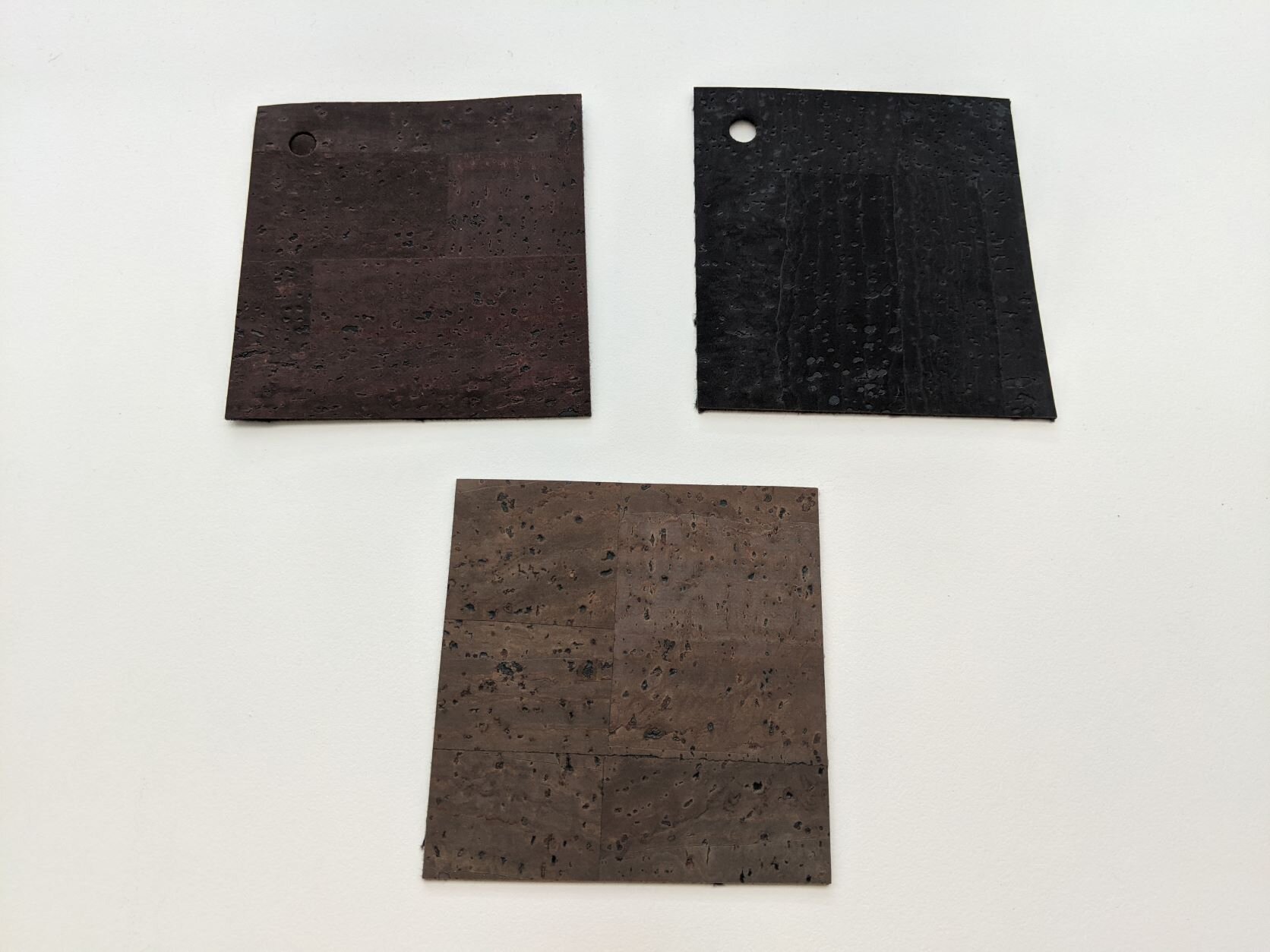Now that you have the pattern for the banana sling bag (available here if you don’t have it yet), let’s dive into the first part of the bagmaking process: choosing your materials. For this bag, we’ll need some exterior material, lining, interfacing and hardware. First, check out this post, which gives background information about all four categories of materials (including recommendations on places to buy). Then, read on below for the materials that I recommend specifically for this sling bag.
EXTERIOR MATERIAL
As I discussed in this post, there are many different materials that you can use to make leather (or leather-look) bags, ranging from genuine leather to leather look-alike materials like faux leather, pineapple leather or cork. For this particular project, you can choose to make the bag out of a pebbled genuine or faux leather, in which case you’ll get a luxurious, more refined-looking bag, or you can go for a sportier, more rustic look by making the sling bag out of pineapple leather or cork fabric. It’s all up to you and your design preferences!
GENUINE LEATHER
If you choose to make your sling bag out of genuine leather, make sure you buy leather that is the right thickness. If you choose leather that is too thick, your bag won’t have that slouchy look, and you’ll end up with something that looks closer to a saddlebag (which might be fine, depending on your preferences). For example, I made this beige version of the sling bag using a 4.5 oz pebbled leather from Rocky Mountain Leather Supply, and my final product ended up being a bit more boxy and structured than I wanted (see below pics).
If I were to make it again, I would choose some leather that is a bit thinner, around 3.5 oz. The good thing is Rocky Mountain Leather Supply will split leather to your desired thickness, so you can choose a leather that is thicker than 3.5 oz and have them thin it down.
In addition to getting the right thickness, you’ll also want to make sure that you choose the right kind of texture. I personally think leather with a pronounced grain (such as a pebbled texture) is the best choice for this rustic, sporty-looking bag.
With the above in mind, here are my recommended leathers for this project:
Minerva Box pebbled veg-tan leather from Rocky Mountain Leather Supply (but split down to 3.5-4 oz). This luxurious pebbled leather comes in lots of different colors, so you can definitely find something that fits your needs. You will need ½ hide (7-8 sq. ft.) of leather.
Studio Sides from Tandy Leather. This leather comes in six different (vibrant) colors and has a nice subtle grain (you can’t really see it from the photos on the website, but I have some of this leather and I can vouch for the fact that it has a grain). The leather is also just the right weight for this project (again, the website doesn’t seem to be 100% accurate here - the website says that the weight is 2.5 to 3 oz, but the piece that I picked up is 3.5 oz.)
FAUX LEATHER
If you don’t have the budget for real leather, or you just don’t want to use genuine leather for ethical reasons, consider making the sling bag out of some high-quality faux leather. Don’t use the horrible low-end stuff that smells of plastic – instead, spend some more money and buy some higher-quality faux leather in the $20-50 per yard price range. That might sound like a lot, but you will only need about ½ yard for this sling bag so you won’t end up spending that much.
Here are my recommendations for faux leather:
Crocodile faux leather from Mood Fabrics. It is available in 11 different colors and costs only $24.99 per yard. I made the sling bag pictured below out of this black faux leather.
Dark brown faux leather from B&J Fabrics. As I’ve said before, I really love the faux leathers from B&J Fabric, a high-end fabric store in the garment district in NYC, and I’ve always been impressed at how nice (and not plasticky!) the faux leather feels. This dark brown faux leather has a nice grain and will approximate the look of a genuine leather bag.
PINEAPPLE LEATHER
I’ve previously rhapsodized about the unique qualities of Pinatex, or pineapple leather, and I think that the rustic look of Pinatex would be perfect for this sling bag. You can check out pics of my Pinatex sample book here. For this bag, I would be inclined to go with the original version of Pinatex, which has a distinctive rough grain and comes in 11 different colors. The finished product would end up looking similar to this.
CORK
Another great choice for this sling bag is cork fabric (i.e., cork material bonded to a fabric backing. You can read more about what cork fabric is here). For this bag, I think the cork fabrics from Fabric Funhouse would be a great choice. Although these fabrics don’t have a grain, they do feature variation in the colors, which gives the fabric some depth and visual interest. (See below pics of samples of these cork fabrics.) You will need a large piece (18 in. x. 54 in.) for this sling bag, which will cost you $40.98. Personally, I would go with the black or dark chocolate cork fabrics, to get a sling bag that looks close to a genuine brown or black leather bag.
LINING MATERIAL
As I have explained before, it’s not necessary to line this bag, but the lining will give the interior of the bag a lovely finished look. You can either use genuine leather to line the bag, or go with a faux leather alternative like microsuede/Ultrasuede.
PIGSKIN
If you’re making your bag out of genuine leather and you’d like the lining to also be genuine leather, consider lining the bag with pigskin leather lining. You can find pigskin lining in most of the major leather online stores – for example, Tandy offers this pigskin lining leather in beige and black.
MICROSUEDE/ULTRASUEDE
My personal preference for most leather bag projects (including this one) is to use microsuede lining. My favorite microsuede lining is this Italian microsuede from Rocky Mountain Leather, which comes in beige and black. It feels really soft and smooth to the touch, and it’s also quite thin, so it’s a good choice if your exterior material is already quite thick and you need to keep the layers from getting too bulky. (We will be gluing the exterior material to the lining material, so we need to make sure the combination of the two materials isn’t too thick.) I lined the inside of the beige sling bag using this microsuede lining.
Another option is to line the sling bag in Ultrasuede, which is what I did with my black sling bag. (See pic of the interior below.) Ultrasuede is water resistant, which makes the bag interior very easy to clean. On the other hand, Ultrasuede is quite pricey (for example, Ultrasuede Soft runs around $60 per yard) and it is also quite thick, so it’s not a great choice if your exterior material is quite thick.
You can find a large selection of colors of Ultrasuede Soft at B&J Fabrics. I used this cream colorway.
INTERFACING
The top piece in this bag needs to be interfaced to give it the structure it needs to stay flat. I recommend using Decovil Heavy, which you can purchase from Joann’s Fabrics. You’ll only need a tiny bit of it (less than ¼ yard).
Hardware
The final step is to collect all of the hardware you need for this bag. You can find a lot of bag hardware from places like Michael’s and Jo-Ann Fabrics, but I personally like to buy my hardware from either Botani Trim or Pacific Trimming, two trim stores located in the Garment District in NYC. Their hardware is very good quality, and their online selection is fairly extensive (though nowhere near the mind-boggling selection that is available in their physical stores).
For this sling bag, you’ll need the following:
A closed-end, one-way 12-inch zipper (preferably with heavy-duty teeth). I like this heavy-duty zipper with large metal teeth, available in gold and antique brass from Botani Trim. Make sure you pick a zipper with the same metal as the rest of your bag hardware.
Two one-inch/25mm wide D-rings. You can get these at Botani Trim in gold, nickel, gunmetal, antique gold and black.
Two one-inch/25mm wide swivel hooks. Also available from Botani Trim in gold, nickel, gunmetal and antique gold.
One one-inch/25mm slider/buckle. Available from Botani Trim in gold, matte silver, matte gunmetal, antique gold and black.
EQUIPMENT
In addition to collecting your materials, you’ll also need to make sure you have all of the equipment you need to make the bag. This includes leather machine needles, a walking/teflon/roller foot, clips, rubber cement, leather glue, heavy-duty thread and edge paint. Head on over to this post to learn about this equipment and where to buy them.
And that’s it – we’ve now gathered all of the materials for the banana sling bag! Next, let’s start cutting and prepping the pieces of the bag…















